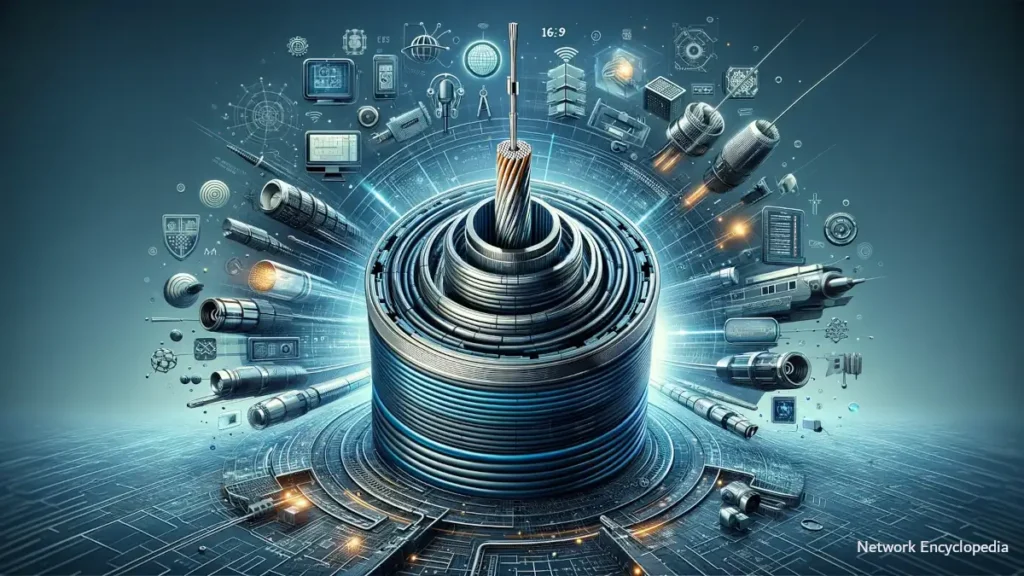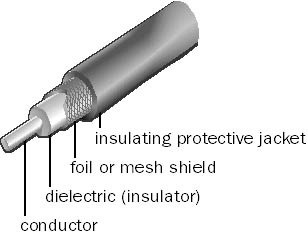Coaxial cabling, often referred to as “coax,” plays a foundational role in the history of network cabling. Its construction features two conductors running concentrically along the cable’s axis, a design that has served various technological needs over the decades. Although the advent of twisted-pair and fiber-optic cabling has shifted the landscape, coaxial cabling remains relevant, especially in environments with specific requirements.
Table of Contents
- What is Coaxial Cable?
- How Coaxial Cable Works
- Types of Coaxial Cables
- Types of Connectors
- Uses of Coaxial Cables
- Coaxial Cabling in Electromagnetic Interference (EMI)
- Difference between RG-59 and RG-6
- Video
- Conclusion
- References

1. What is Coaxial Cable?
Coaxial cable, a cornerstone in the field of telecommunications, is distinguished by its unique construction. At its core lies a solid copper conductor, ensconced in successive layers: inner insulation, aluminum foil, a copper braided mesh, and an outer protective jacket. This meticulous design optimizes signal integrity by effectively minimizing interference. The use of a solid copper core enhances signal transmission efficiency, while the surrounding layers ensure robust shielding. Insulation materials, typically PVC or advanced non-stick variants, contribute significantly to the cable’s durability and overall performance.

The name «coax» comes from its two-conductor construction in which the conductors run concentrically with each other along the axis of the cable.
Coaxial cabling has been largely replaced by twisted-pair cabling for local area network (LAN) installations within buildings, and by fiber-optic cabling for high-speed network backbones.
2. How Coaxial Cable Works
Coaxial cabling generally consists of a solid copper core for carrying the signal, covered with successive layers of inner insulation, aluminum foil, a copper braided mesh, and outer protective insulation. A solid conductor provides better conductivity than a stranded one, but is less flexible and more difficult to install. The insulation is usually PVC (polyvinyl chloride) or a non-stick coating; the aluminum foil and copper mesh provide shielding for the inner copper core. The mesh also provides the point of grounding for the cable to complete the circuit.
Coaxial cabling comes in various types and grades. The most common are
- Thicknet cabling, which is an older form of cabling used for legacy 10Base5 Ethernet backbone installations. This cabling is generally yellow and is referred to as RG-8 or N-series cabling. Strictly speaking, only cabling labeled as IEEE 802.3 cabling is true thicknet cabling.
- Thinnet coaxial cabling, which is used in 10Base2 networks for small Ethernet installations. This grade of coaxial cabling is generally designated as RG-58A/U cabling, which has a stranded conductor and a 53-ohm impedance. This kind of cabling uses BNC connectors for connecting to other networking components, and must have terminators at free ends to prevent signal bounce.
- ARCNET cabling, which uses thin coaxial cabling called RG-62 cabling with an impedance of 93 ohms.
- RG-59 cabling, which is used for cable television (CATV) connections.
In addition, a number of special types of coaxial cabling are sometimes used for certain networking purposes. An example is twinax cabling, which consists of two conductors first enclosed in their own insulation and then enclosed in a single copper mesh and insulating jacket. Twinax is used in legacy IBM networks for connecting AS/400 systems to 5250 terminals. Other more exotic varieties include triax, quadrax, and ribbon types of coaxial cables.
3. Types of Coaxial Cables
Diversity in coaxial cable types ensures suitability across various applications:
- Thicknet (RG-8 or N-series): The backbone of legacy 10Base5 Ethernet, marked by its yellow sheath and adherence to IEEE 802.3 standards.
- Thinnet (RG-58A/U): Ideal for 10Base2 networks, featuring a 53-ohm impedance and requiring terminators to prevent signal bounce.
- ARCNET (RG-62): Facilitates ARCNET connections with its 93-ohm impedance, demonstrating network design flexibility.
- RG-59: Common in cable television, linking audiences to content. Specialized types like twinax, triax, quadrax, and ribbon cables address specific networking needs, from traditional IBM systems to advanced military technologies.
4. Types of Connectors
Coaxial cable connectors, both male and female, vary widely:
- BNC (Bayonet Neill-Concelman): Employed in video and radio signals below 4 GHz.
- TNC (Threaded Neill-Concelman): A threaded variant for cellphones, functioning up to 12 GHz.
- SMA (SubMiniature version A): Used in Wi-Fi, microwave systems, and radios, operating up to 18 GHz.
- SMB (SubMiniature version B) and QMA: Serve telecommunications and industrial applications, with QMA offering quick-locking features.
- RCA: Facilitates audio and video connections, known as A/V jacks.
- F connectors: Predominant in cable and digital TV, compatible with RG-6 or RG-59 cables.
5. Uses of Coaxial Cables
Coaxial cables serve a pivotal role across a broad spectrum of applications, owing to their robust design and shielding capabilities. In the realm of telecommunications, these cables are instrumental in transmitting cable television signals, ensuring viewers receive high-quality audio and visual content. Internet service providers also rely on coaxial cables for broadband internet connections, capitalizing on their ability to carry large amounts of data at high speeds.
In professional settings, coaxial cables are indispensable for radio frequency (RF) transmission, including connections to antennas and for the transmission of cellular and microwave signals. Their superior shielding makes them ideal for environments where interference from external sources is a concern, preserving the integrity of the signals being transmitted.
Beyond traditional uses, coaxial cables find applications in security systems, where they connect video surveillance cameras to monitoring systems, providing reliable, interference-free video feeds. The aerospace and automotive industries also utilize coaxial cables, taking advantage of their durability and performance for critical communication and sensor systems.
Innovative applications of coaxial cabling include its use in scientific instruments, where precision and reliability are paramount. Laboratories and research facilities use coaxial cables to connect equipment and sensors, ensuring accurate data transmission free from external noise and interference.
6. Coaxial Cabling in Electromagnetic Interference (EMI)
The inherent design of coaxial cables, with their concentric layers of shielding, provides exceptional protection against electromagnetic interference (EMI). This makes them especially valuable in industrial environments, where machinery and electronic devices can generate significant levels of EMI, potentially disrupting data transmission and signal integrity. By effectively enclosing the signal within the cable and grounding the outer shield, coaxial cables ensure that stray interference is absorbed and dissipated, maintaining the clarity and reliability of the transmitted information.
This capability is also critical in medical settings, where the accuracy and reliability of electronic equipment are essential. Coaxial cables are used to connect diagnostic and monitoring devices, safeguarding against the potentially harmful effects of EMI on sensitive medical data. Similarly, in scientific research, where experiments may involve delicate measurements, the shielding provided by coaxial cables is indispensable for preventing data corruption.
7. Difference between RG-59 and RG-6
The distinction between RG-59 and RG-6 coaxial cables lies in their construction and intended use, making them suited to different applications. RG-59, with its thinner diameter and lower bandwidth capacity, was traditionally used in older analog video applications, including CCTV systems. Its relatively higher attenuation rate makes it less suitable for longer distances or higher frequency signals.
In contrast, RG-6 is designed to accommodate the demands of digital and high-definition signals, featuring a larger conductor and enhanced shielding. This construction reduces signal loss over longer distances and provides better protection against EMI and radio frequency interference (RFI), making it the preferred choice for digital cable television, satellite installations, and broadband internet connections.
The choice between RG-59 and RG-6 depends on the specific requirements of the installation, including signal frequency, distance, and environmental factors. RG-6’s superior performance characteristics make it the more versatile and widely adopted option in modern telecommunications and broadcasting applications.
8. Video
9. Conclusion
Despite the evolution of networking technologies, coaxial cabling retains its significance. From its robust construction ideal for minimizing interference to its applicability in specialized and industrial environments, coaxial cabling embodies resilience and versatility. As network infrastructures continue to evolve, the legacy and ongoing utility of coaxial cabling serve as a testament to its enduring value in the complex tapestry of data communication technologies.
10. References
- IEEE 802.3 Standards for Thicknet Cabling
- Technical Specifications for RG-58A/U, RG-62, and RG-59 Cabling
- Ring Topology, Network Encyclopedia
- Terminators to one end of a bus or cable, Network Encyclopedia